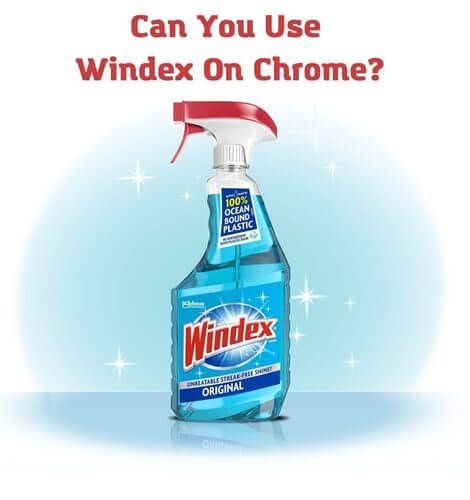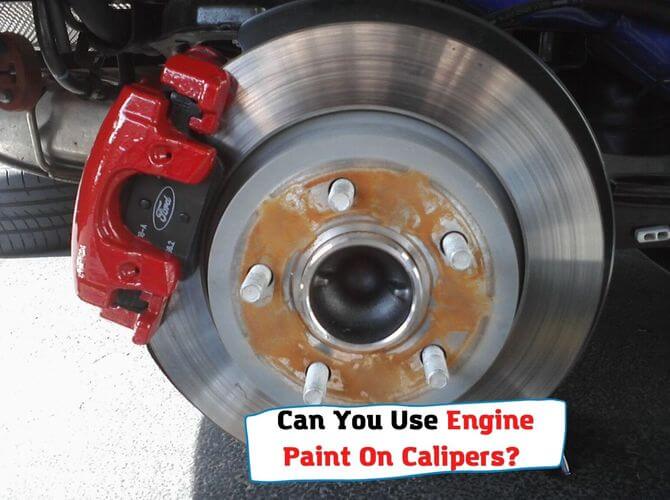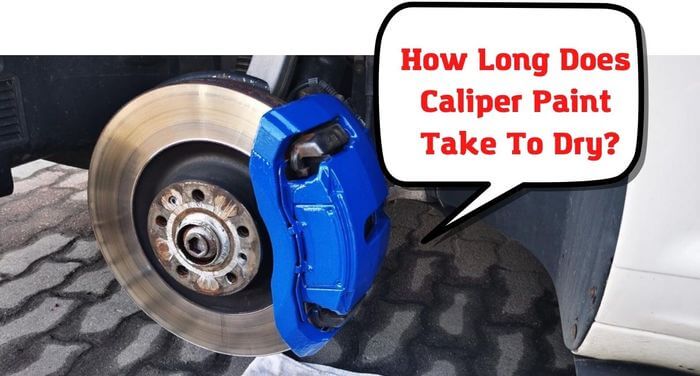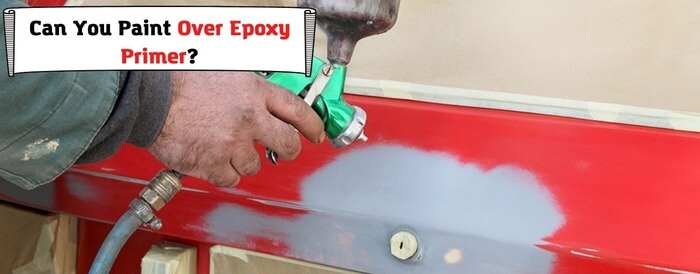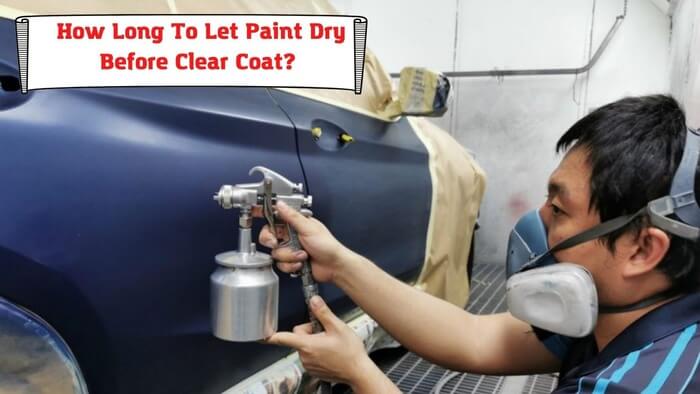
If you only start your way in automotive painting, you will be surprised to find hundreds of new terms. Basically, we can divide all automotive paint types into two major groups: base coats and clear coats. Within those groups, you will find dozens of types that differ according to their main materials and components. But the main difference between these paint types is that the base coat gives you the color while the clear coat gives the base coat some protection.
With a decent clear coat, your car looks nicer. The color looks kind of wet and deep, and the car stays shiny for a longer time. That’s why applying clear coats is an important step in painting a car body. Actually, it’s a good way to paint all smooth metal parts, not only car parts. But the price of a decent painting seems to be too high in this case.
In our today’s article we’ll discover some important things:
- How long is too long for a clear coat?
- Optimal waiting time before applying clear coat materials.
- Main tasks of the clear coat.
- What if I don’t apply a clear coat to my car?
- Main rules of applying clear coat.
- The most popular mistakes when working with clear coats.
Let’s get started!
Can I apply a clear coat after 24 hours or after a week?
This highly depends on what base coat materials you choose. But in most cases, waiting for more than 24 hours will be too long. If you applied your base coat a week ago, you shouldn’t just spray some clear coat materials over it. The base material is fully dry now, it has hardened and cured completely, so it won’t benefit even a bit from having any clear coat over it.
The idea in using all these multi-coat paint types is that all coats create kind of a blend. And in the end, you get wonderful paint that protects the metal from corrosion and is protected from sunbeams, water impact, and even physical damages. But if each coat is applied over a hardened previous coat, nothing will work that way. Your clear coat is likely to peel off once influenced by any damaging factors. And of course, making it quite smooth if the base coat has fully cured is not that easy. We know one trick, though. You may use wet sanding with 1000 or 1200 grit sandpaper to prepare your base coat. In this case, the clear coat will stick to the base and will form a proper blend with it.
So, you can apply a clear coat after 24 hours of applying your base coat, but waiting for more than that is irrational. You will need to follow our instructions on how to apply a clear coat if you had to wait for more than 1 day after finishing with your base coat.
Optimal waiting time between two coats
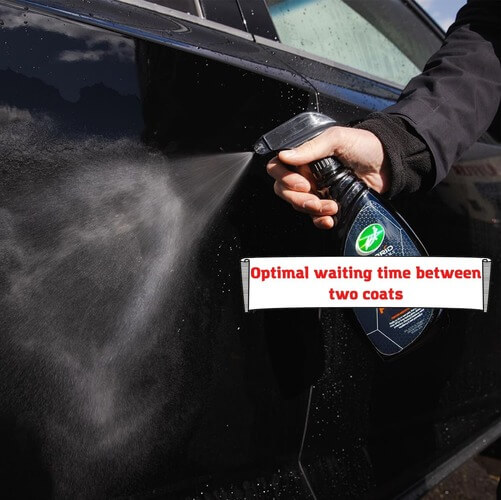
Again, it all depends on what kind of paint you use. But in most cases, the optimal time will be anywhere between 30 minutes and 5 hours. You may wait longer, but applying your clear coat sooner than 30 minutes after you are done with the base color is an insane idea, especially for a beginner. Your task is to let two coats blend together to form one paint layer over your metal part.
Here’s what happens if you start too early:
- the base coat is still wet and unstable;
- you can easily ruin the smooth paint by just making anything wrong;
- it’s obvious that in some parts your paint will drop and form a track on a base coat;
- the blending of two coats may be too obvious they will just mix;
- such painting is unforgiving – it’s hard to correct any mistakes;
- the durability of the paint is affected much.
Also, if you decide to wait for more than 1 day, you will get some other problems. Mainly, your base coat will be too hard to form any kind of blend with a clear coat. This means that the clear coat won’t have any possibility to stick to the base. Quite soon the clear coat will just peel off and let your base be damaged by sun or water. Such paint won’t survive for a long time. It’s also very hard to achieve a smooth coating in this case.
What’s the main purpose of a clear coat?
Clear coats are very important when you paint cars or bikes. They will protect your base color, they will also make it look better. Without a clear coat, your car will look dull very soon. The problem is that paint is affected by sunlight, water, heat, and frost. If left without a clear coat, the paint will survive a year or two and will start shading, discoloring, peeling off, etc. Also, it won’t shine at all after it has cured.
Clear coat helps you achieve a lot of wonderful effects:
- protection from ultraviolet rays (sunlight) – the color doesn’t shade much;
- protection from dust and other contaminants – the paintwork is easily cleaned and not damaged;
- protection from chemical impacts – like that of bird drops or acid rains, for example;
- protection from scratches and dents thanks to a stronger structure than that of a base coat.
Thanks to clear coats, automotive paintwork can survive for more than 10 years without major changes. If manufacturers didn’t use the clear coats, the paint would only survive for one or two years. So now you can see that a clear coat is extremely important in car painting. Let’s move on to talk about time issues and some other mistakes a person can make when painting a car body part.
Can you paint a vehicle without a clear coat?
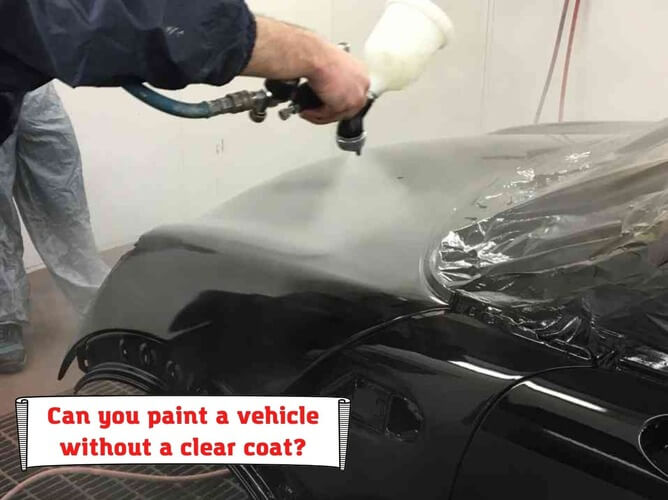
Actually, a clear coat is a part of an automotive paint job. If you just use a base coat, your car will look weird, won’t have shine, won’t be protected from rains, mud, dust, sun, or any other damaging factors. Rust will come in just a couple of weeks to tell you that you weren’t right when you decided to not put clear coat.
You can find some automotive paints that contain a clear coat in them. So these are kind of all-purpose paints that can be applied in a couple of layers and they will form a special protective film over the color when curing. But unfortunately, these types of paint aren’t that good for painting your vehicle. You may use them to paint your fence or maybe your fridge, but painting a vehicle with such materials will not be a good idea.
For over a century, experts have been developing technologies for painting cars. And the system with a base coat and clear coat has proved to be the best option for this purpose. If applied correctly, this paint job will last for years and sometimes even for decades without peeling off or losing much color. That’s why you should choose this method if you want to repaint your car.
Rules for applying automotive paints
If you don’t have much experience, you should gather some information prior to buying and applying any materials. First, you will need to choose paint and this is extremely important. Also, you will need some hardeners, solvents, instruments, primers, and other materials that are needed in a car body repair.
But today we’ll focus on applying a clear coat. Let’s assume, you have successfully applied at least three coats of base coat and you are ready for making a clear coat. Here are some rules you should remember:
- Don’t apply your clear coat until the surface of the base coat starts curing. Under cold temperature or high humidity, this may take more time than expected.
- Don’t wait for too long – we’ve already discussed that the optimal time will be anywhere between 30 minutes and 24 hours.
- Apply thin coats of clear coat one after another – no need to wait for more than 15 minutes between coats.
- Apply 3 to 4 layers of clear coat, you may do more but it doesn’t make much sense. But if you make only two layers, the protection won’t be that good.
- Be careful and look for any mistakes because you can correct them right at the time when you are applying a clear coat.
- Don’t make thick layers, otherwise, you will just need to repaint the spot again.
After you are done with applying all needed coats, just let the vehicle rest for 24 hours. It’s highly recommended to paint your car in a place with no dust and dirt. Excessive dust may lead to some dust particles just sticking to your freshly applied paint.
Some experts recommend wet sanding over a clear coat. We don’t think it’s a good idea, because you may just take off one or two coats of the clear coat when you try sanding it. We would go for buffers and try to buff out the vehicle to give it some shine. Also, while buffing your car after painting you will deal with any minor mistakes that may make your car look not so fresh after it’s painted.
What mistakes occur when applying a clear coat?
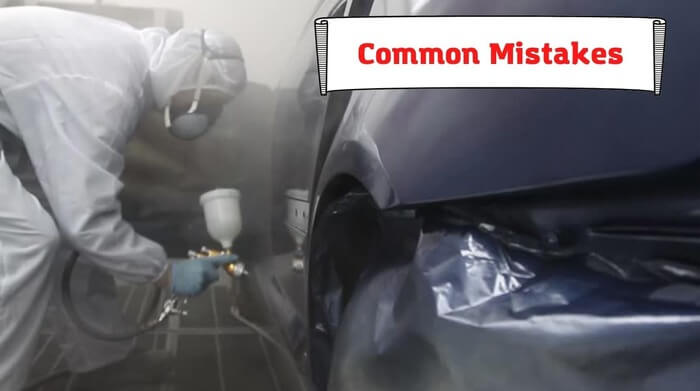
Troubles after applying a clear coat are very unwanted. They ruin all the job you have done and make you repaint the car, spend some more days in your garage. These problems often include uneven paint, color changes, drops, paint runs, etc. If you experience something like this, you have made a mistake when applying one of the coats.
We’ve found out which mistakes are the most popular when people without much experience paint their cars and specifically apply clear coats:
- Using bad thinners and reducers for topcoat materials. This will make your clear coat crack and peel off without forming any bonds with a base coat.
- Too much hardener in the clear coat. This problem leads to immediate hardening which is bad for your final results. The little cracks may appear on your paint job quite soon.
- Bad conditions while curing. You may know that cars should be painted with special cameras with proper temperature and humidity. Once the conditions are not ideal, the results may be poor.
- Too thick layers. If you make clear coats too thick, they will crack eventually or just won’t cure properly. This will lead to a bad paint job.
- Cheap or just inappropriate spray gun. This problem may lead to thicker layers, “orange peel” effect, uneven coating, etc.
- The bad technique of painting. Please make sure you know how to hold your spray gun, how to position its tip, and how to move it around the metal parts to achieve better results.
- Quick coats. This is a very common problem. Inexperienced painters will apply the next coat while the previous one hasn’t cured even a bit. This will lead to paint runs and sags.
- Poor pressure. A spray gun is connected to a compressor. You should check which pressure should be set before spraying some paint on your metal parts.
- Poor ventilation. If your camera lacks ventilation, the coats won’t cure well enough before you apply other coats. This will lead to an improper blending of coats and troubles with your paint job.
These are the most common mistakes that people make when painting their cars. If you have no experience in painting, better consult the specialist or at least read all instructions for the materials you buy. Also, watch some videos about the process of painting cars and keep an eye on small details like painting techniques, spray gun types, compressor settings, etc. After checking these factors, you are ready to paint your vehicle without all those problems and mistakes.
What if your paint is bad?
Here’s another trouble we should outline. Sometimes people who don’t paint cars on a daily basis just don’t know how to choose proper materials. And because of this, they can buy cheap and bad paints, primers, thinners, reducers, and hardeners.
Make sure you buy these products in a specialized shop that can give advice on choosing the proper materials for your purpose. Your choice will influence the results much. And even if you don’t make any mistakes in the process of painting, bad paint will ensure you won’t be glad about the results.
Final words
As you may see, painting a car is quite difficult. You should understand how this works before taking a spray gun in your hands. But nothing is impossible, so we can learn how to paint metal parts. We recommend you try your skills on a separate piece of metal. Once you are able to paint it with no problems, you may start painting your car. Of course, we highly recommend doing your first paint job under the control of an experienced specialist who can help if you do something wrong.
- Can You Unmix Paint: Techniques, Consequences, Alternatives - February 23, 2024
- Does Primer Need to be Mixed? Effective Primer Application - February 22, 2024
- How to Make Old Paint Usable Again: Retrieving and Preserving Paint - February 21, 2024
